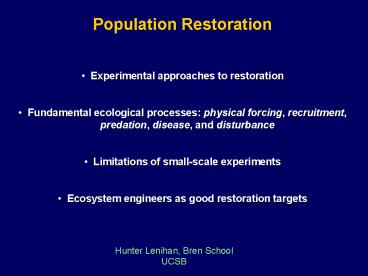Physicalbiological coupling in coastal ecosystems - PowerPoint PPT Presentation
1 / 59
Title:
Physicalbiological coupling in coastal ecosystems
Description:
Fishery disturbance (reef height reduction) x Nutrient-loading (hypoxia/anoxia) ... Reduce reef degradation caused by dredging ... – PowerPoint PPT presentation
Number of Views:53
Avg rating:3.0/5.0
Title: Physicalbiological coupling in coastal ecosystems
1
Population Restoration
- Experimental approaches to restoration
- Fundamental ecological processes physical
forcing, recruitment, predation, disease, and
disturbance - Limitations of small-scale experiments
- Ecosystem engineers as good restoration targets
Hunter Lenihan, Bren School UCSB
2
Pamlico Sound, NC
3
(No Transcript)
4
Ecological goods and services provided by oysters
- Fishery (vastly reduced) - Bio-filtration
that maintains water quality (widespread
eutrophication and hypoxia/anoxia) - Engineering
of reefs in estuaries (gt50 reduction in reef
area) - Prey for other species in estuarine food
web
5
Oyster harvests in North Carolina
3000
2500
2000
Annual oyster harvests (metric tons)
1500
1000
500
0
1920
2000
1880
1890
1900
1910
1930
1940
1950
1960
1970
1980
1990
Year
6
Seagrass
Coral reefs
Salt marsh
7
(No Transcript)
8
(No Transcript)
9
NC restores oysters populations to maintain
fishery
10
gt1 million per year to restore lt300,000 per
year in oyster production
11
Oyster harvests in North Carolina
3000
2500
2000
Annual oyster harvests (metric tons)
1500
1000
500
0
1920
2000
1880
1890
1900
1910
1930
1940
1950
1960
1970
1980
1990
Year
12
Habitat restoration has not enhanced oyster
harvests Why?
13
Habitat restoration has not enhanced oyster
harvests Why? -habitat degradation
continues -many oysters die of disease prior
to reaching harvest size (7 cm)
-takes 1.5-3 yrs to reach harvest size
-disease kills oysters at 2 yrs old
14
(prefer other oysters gregarious settlement)
Where is the population bottleneck?
15
Small, dead oysters
Hypothesis poor quality of reefs low
recruitment, slow growth, high mortality
16
Pilot study
Test potential mechanisms that may limit
population
Does flow influence oyster growth?
17
Laboratory experiment to test effect of flow on
growth
Juvenile oysters
18
16
14
12
10
Growth in shell height (mm)
8
6
4
2
0
2.5
5
7.5
10
Flow speed (cm/sec)
19
How could you manipulate flow speeds to
influence oyster populations?
20
Reef shape influences flow. Flow influences
oyster growth, perhaps also recruitment
survival
21
Working hypothesis
Oyster production is limited by hydrodynamic
conditions on reefs
- Reef size influences flow
- Flow controls sedimentation
- Flow influences recruitment, growth survival
- Flow effects disease intensity prevalence
22
Exploited a management problem
- Collaborated with regulatory agencies
- Manipulated restoration program fishing
regulations - large-scale experiment to tests new
- restoration methods
23
Experimental reefs
24
(No Transcript)
25
(No Transcript)
26
(No Transcript)
27
- Current meters to measure flow speed
28
Flow
2 m
0.1 m
(Lenihan 1999)
29
r20.88
30
- Measuring oyster recruitment
31
(No Transcript)
32
Recruitment over 3 month period
33
- Measuring growth, condition, and survival
- Genetically similar oysters to reduce variability
in response - Out-planted oysters to experimental reefs
34
Growth Rate
Harvest size
35
Survival Rate
survival/18 mo.
r2 0.77
N 12 reefs 3064 oysters
Mean flow speed (cm/sec)
36
Prevalence of Perkinsus marinus infection
r2 0.73
N 12 reefs 3064 oysters
37
Recommendations
- Restore reefs that mimic natural natural ones
(adequate height)
38
When models based on small-scale experiments
fail
Ecological impacts of multiple stressors
39
Why mass mortality of oysters in deep water?
Experimental design to test hypotheses?
40
Hydrographic conditions in the Neuse River estuary
41
Dissolved O2 (mg/l)
42
(No Transcript)
43
Ecological interactions combinations of
stressors can cause additive or synergistic
effects in ecosystems
Fishery disturbance (reef height reduction) x
Nutrient-loading (hypoxia/anoxia) mass
mortality of oysters
44
Conservation plus enhanced
45
Ecological goods and services provided by oysters
- Do reefs provide habitat for other species of
ecological - and value?
- If so, should we manage oysters differently?
46
- Are oysters important habitat for blue crabs and
- commercially valuable fish species?
- Sampled crabs and fish populations, and
populations of prey
47
(No Transcript)
48
(No Transcript)
49
Maybe they are a good temperate latitude analogue
of coral reefs!
50
20
3 m, tall reefs
16
12
8
4
0
20
3 m, short reefs
16
12
8
4
No. fish/trap
0
20
6 m, tall reefs
16
12
8
4
0
20
6 m, short reefs
16
12
8
4
0
31 May
6 July
18 July
20 July
5 Aug
3 Sept
13 June
1997
Hypoxia/anoxia
51
3 m, tall reefs
3 m, short reefs
6 m, tall reefs
No. benthic prey/trap
6 m, short reefs
15 May
7 July
20 July
24 July
6 Aug
3 Sept
10 June
1997
Hypoxia/anoxia
52
Recommendations
- Restore reefs that mimic natural reefs
- Avoid deep hypoxic areas unless reefs are gt2-m
tall - Reduce reef degradation caused by dredging
- Restore reefs in sanctuaries to increase
broodstock, habitat for other organisms - Address water quality issues
Lenihan 1999 Lenihan and Peterson 1998, 2004
Lenihan et al. 1995, 1999, 2001 Jackson et al.
2001 Ruesink et al. 2005 Lotze et al. 2006
53
- Restoring populations of bay scallops in NC
Argopectins irradians
54
- Red tide advected in Gulf Stream from Florida in
1987 - Entered NC estuaries via warm core ring
- Wiped out scallops in all NC sounds
55
- Scallop population declines
- Area specific recovery
56
- Scallop population of coastal
- NC consists of many sub-
- populations connected by
- larval transport and recruitment
- Bogue Sound hydrographically
- isolated from other sounds
- Why did Bogue Sound populations
- not recover?
57
- Transferred 100 thousands of scallops
- Increased density in receiver sites
58
- Measuring scallop recruitment after
transplants
59
- Reestablished recruitment in Bogue Sound
- Example of recruitment limitation































